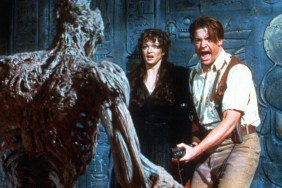Directed by Juan Carlos Fresnadillo
Summary:
“28 Weeks Later” tries way too hard to recapture the magic of the first movie. Although it does get a few things right, it adds little to the premise because it lacks the emotional impact of the original movie, replacing it with more common horror movie cliches.
Story:
28 weeks after the Rage virus has seemingly been eradicated in England, a family is reunited in London’s safe zone, which has been kept under the control of the U.S. military. When the virus reemerges and starts a new outbreak, the survivors need to survive not only attacks from the infected but also the soldiers who have been given orders to kill everyone.
Analysis: As difficult as it must be to create a satisfying sequel, it must be even tougher when a movie is so far ahead of its time and genre, and you’re trying to make a sequel without the creative team and cast that made it so special. “28 Days Later” director Danny Boyle and screenwriter Alex Garland personally selected Spanish filmmaker Juan Carlos Fresnadillo (“Intacto)” to take up the baton for the sequel to their 2003 post-apocalyptic thriller with the presumption that a sequel would be a no-brainer. In “28 Weeks Later,” Fresnadillo offers an interesting scenario that continues where the last movie left off, focusing on a different set of characters caught in the mayhem that once was Jolly Ol’ England. The film opens with a group of survivors holed up in a country cottage that’s promptly attacked by a crazed mob of the infected. Robert Carlyle’s Don only barely manages to escape, deserting his wife Alice (Catherine McCormack) to the infected in a cowardly move that will haunt him later. 28 weeks later, Don is living in London’s District 1, an island safe zone that has been cleaned-up ready to renew life in the city as bored American soldiers are stationed on rooftops with sniper rifles just in case things go wrong again. Don is soon reunited with his kids Andy and Tammy, who were out of the country during the outbreak, though he doesn’t tell them about his cowardly part in their mother’s death. Shockingly, Alice has somehow survived being attacked by the infected, because something in her blood makes her immune to the effects. Because she’s still a carrier of the disease, it doesn’t take long for the Rage virus to start infecting people again (with a surprising twist we won’t reveal). By then, it’s already 45 minutes into the movie and we’re as bored as the soldiers, but as the military loses control amidst the ensuing chaos, the situation is elevated to “Code Red” which essentially means killing every single person on the streets whether infected or not. A scientist named Scarlet (Rose Byrne) realizes that Andy and Tammy may have the same immune blood as their mother, so she and a renegade soldier (Jeremy Renner) tries to save them, racing through the streets that pose dangers both from the infected and the overzealous soldiers there to prevent another outbreak. While the original movie was effectively disturbing in the way it showed how England is leveled by a deadly outbreak, that premise and the location is the only thing retained for the sequel. London once again makes the perfect backdrop for chaos as we see plenty of gorgeous tracking shots over the city roofs and empty streets. The new characters, essentially a bunch of soldiers and a couple kids, aren’t nearly as interesting as the odd group that assembled in the first movie. Most of the performances are fine, but we don’t spend enough time with any of them to establish any strong emotional link, and the lack of focus makes it hard to determine whether the protagonist is supposed to be Don, his kids, Jeremy Renner’s Sgt. Doyle or Rose Byrne’s scientist. In a way, “28 Weeks Later” is more of a horror movie in the way it uses typical cliches of the survivors being chased through the city, grimly killed off one by one in a way that has very little impact on the viewer or their fellow survivors. Gore fiends will probably be impressed by one or two “splatterrific” set pieces, even if the most impressive one involving a helicopter isn’t particularly original. Likewise, a later scene in which they walk through the darkened London Underground using the infrared scope from a sniper’s rifle was done far more effectively in last year’s “Descent.” Most of the time, things are happening so fast in such dark places that it’s hard to figure out what’s going on. The only truly shocking moment comes at the height of the chaos when the soldiers start firing on the crowd with the orders to kill everyone. America was barely at war when the original movie made bad guys out of the military, but the sequel’s veiled parallels to the situation in Iraq seem like a poorly timed indictment of men “just following orders” in order to show America’s excessive use of force to deal with situations beyond their control. (Last time I checked, the British are just as much a part of the FUBAR in Iraq as the U.S.) Other than that, the movie rarely tries to find its own identity, obvious from the fact that it uses the exact same music from the original movie during the more intense scenes in hopes of creating a similar effect. Because the characters haven’t been established in a way that makes us care about them, it’s not nearly as effective. The sequel’s worse offense comes with the lame “cliffhanger” ending that tries to leave things open-ended for a third movie, just in case it’s not obvious that the premise will continue to be milked for all its worth as long as it continues to bring in money.
The Bottom Line:
If you liked “28 Days Later,” you’ll probably want to see this passable sequel just to see how things get out of control again, though it does presume that most people will have seen the original movie. Either way, it’s hard not to think that this is very much like George Romero’s “Day of the Dead” was to “Dawn of the Dead,” the latter being considered a classic while its sequel was little more than an afterthought done to cash in, without being nearly as satisfying.










